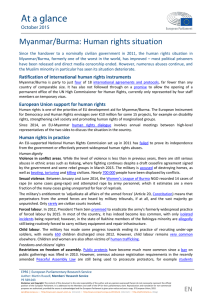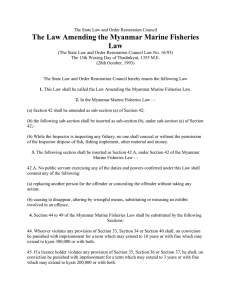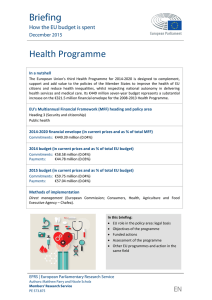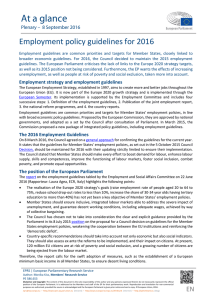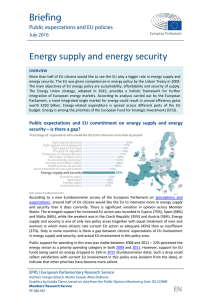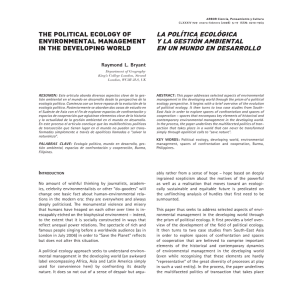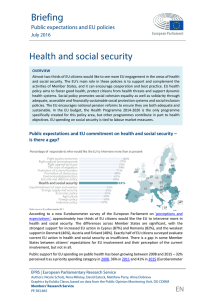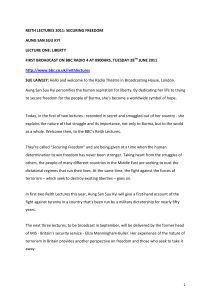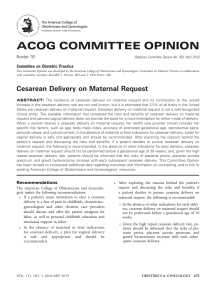Briefing European Parliamentary Research Service
Anuncio
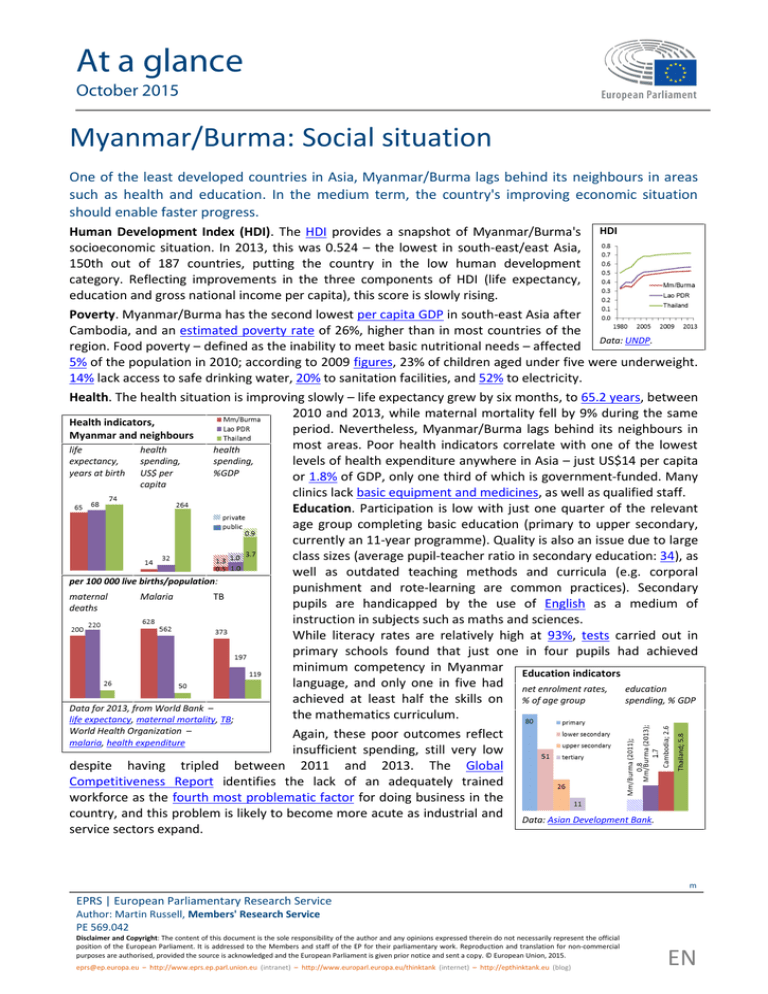
At a glance October 2015 Myanmar/Burma: Social situation One of the least developed countries in Asia, Myanmar/Burma lags behind its neighbours in areas such as health and education. In the medium term, the country's improving economic situation should enable faster progress. Human Development Index (HDI). The HDI provides a snapshot of Myanmar/Burma's HDI socioeconomic situation. In 2013, this was 0.524 – the lowest in south-east/east Asia, 150th out of 187 countries, putting the country in the low human development category. Reflecting improvements in the three components of HDI (life expectancy, education and gross national income per capita), this score is slowly rising. Poverty. Myanmar/Burma has the second lowest per capita GDP in south-east Asia after Cambodia, and an estimated poverty rate of 26%, higher than in most countries of the Data: UNDP. region. Food poverty – defined as the inability to meet basic nutritional needs – affected 5% of the population in 2010; according to 2009 figures, 23% of children aged under five were underweight. 14% lack access to safe drinking water, 20% to sanitation facilities, and 52% to electricity. Health. The health situation is improving slowly – life expectancy grew by six months, to 65.2 years, between 2010 and 2013, while maternal mortality fell by 9% during the same Health indicators, period. Nevertheless, Myanmar/Burma lags behind its neighbours in Myanmar and neighbours most areas. Poor health indicators correlate with one of the lowest life health health expectancy, spending, spending, levels of health expenditure anywhere in Asia – just US$14 per capita years at birth US$ per %GDP or 1.8% of GDP, only one third of which is government-funded. Many capita clinics lack basic equipment and medicines, as well as qualified staff. Education. Participation is low with just one quarter of the relevant age group completing basic education (primary to upper secondary, currently an 11-year programme). Quality is also an issue due to large class sizes (average pupil-teacher ratio in secondary education: 34), as well as outdated teaching methods and curricula (e.g. corporal per 100 000 live births/population: punishment and rote-learning are common practices). Secondary maternal Malaria TB pupils are handicapped by the use of English as a medium of deaths instruction in subjects such as maths and sciences. While literacy rates are relatively high at 93%, tests carried out in primary schools found that just one in four pupils had achieved minimum competency in Myanmar Education indicators language, and only one in five had net enrolment rates, education achieved at least half the skills on % of age group spending, % GDP Data for 2013, from World Bank – the mathematics curriculum. life expectancy, maternal mortality, TB; World Health Organization – Again, these poor outcomes reflect malaria, health expenditure insufficient spending, still very low despite having tripled between 2011 and 2013. The Global Competitiveness Report identifies the lack of an adequately trained workforce as the fourth most problematic factor for doing business in the country, and this problem is likely to become more acute as industrial and Data: Asian Development Bank. service sectors expand. m EPRS | European Parliamentary Research Service Author: Martin Russell, Members' Research Service PE 569.042 Disclaimer and Copyright: The content of this document is the sole responsibility of the author and any opinions expressed therein do not necessarily represent the official position of the European Parliament. It is addressed to the Members and staff of the EP for their parliamentary work. Reproduction and translation for non-commercial purposes are authorised, provided the source is acknowledged and the European Parliament is given prior notice and sent a copy. © European Union, 2015. [email protected] – http://www.eprs.ep.parl.union.eu (intranet) – http://www.europarl.europa.eu/thinktank (internet) – http://epthinktank.eu (blog) EN EPRS Myanmar/Burma: Social situation Employment. Forced labour continues, although on a smaller scale than in the past. Child labour is also common. Culprits include the army, ethnic armed groups and, in the case of child labour, human traffickers. Agriculture is the main source of employment, with 70% of the workforce on over 4 million farms. Unemployment. Reliable data are lacking, with estimates of the unemployment rate ranging from 3% (World Bank) to 37% (the country's first national employment survey, 2013). In another survey carried out in 2014 by US-based NGO, International Republican Institute, unemployment was most frequently mentioned (by 19% of respondents) as one of the three biggest problems facing the country. Social protection. Under a Social Security Law enacted in 2012, employees now enjoy benefits including invalidity, injury and unemployment insurance, as well as pensions. A new minimum wage is also an important step forward. However, these measures do not apply to the self-employed, casual workers and those working for family members – around three quarters of the workforce. Environment. Myanmar/Burma has lost one fifth of its forest cover – an area almost three Deforestation % of land times the size of Belgium – since 1990. Nearly half of the country remains forested, but with area covered firewood as the only energy source available to rural populations in the absence of electricity by forest and unsustainably high levels of commercial logging, deforestation will continue, even if government measures such as a ban on exports of unprocessed wood may slow its pace. Though good for the economy, rapid infrastructure development, a booming construction sector and foreign-financed mining and energy projects all come with environmental costs. With three times the number of cars and trucks on the road since 2007, air pollution in Yangon and other large cities is on the rise. Data: UNClimate change. Though Myanmar/Burma itself is not a major producer of greenhouse gases, it REDD. has been identified as the world's second most vulnerable country to climate change, blamed for natural disasters such as Cyclone Nargis in 2008 and the worst flooding in decades in 2015. Regional disparities Inequality. All the above problems are exacerbated by severe disparities. % of population living in poverty (2010) Poverty is much more widespread in rural than urban areas, and there are huge regional variations, with areas inhabited by ethnic minorities such as Chin and Rakhine states the worst affected. These disparities are reflected in unequal access to health and education. Inhabitants of remote areas may have to travel hours to reach their nearest clinic. Rural mothers are much less likely to receive antenatal care and give birth in hospital – key factors in reducing maternal mortality. School attendance rates are also lower in poorer regions. Data: UNDP. Most disadvantaged of all are the Rohingya, victims of persecution and a humanitarian crisis. Many have lost their homes and live in squalid camps; up to 7 000 a month risk their lives to flee the country in flimsy boats. Gender. Gender equality is an area where Myanmar/Burma does Gender equality comparatively well – participation rates for women in education and employment are close to or in some cases even exceed parity. Around one third of senior managers in the civil service and private companies are women – a surprisingly high number even by European standards. On the other hand, politics is still a male-dominated area, with just 6% of parliamentary seats held by women, the lowest rate in ASEAN. That could change soon with the NLD and several other parties fielding record numbers of women candidates in the November 2015 elections. Outlook Myanmar/Burma may remain under-developed for many years to come, but Data 2010-2013: ADB, World Bank brighter economic prospects should also bring social benefits, gradually closing the gap with the rest of the region. At the same time, the experience of neighbouring countries which are further ahead in development suggests that inequalities are likely to persist. Economic development will also put pressure on the environment. Members' Research Service Page 2 of 2
